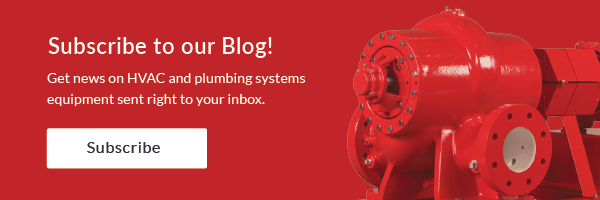 One of the more frequent questions we are asked has to do with ASME label requirements for the thermal expansion tank on water heaters. When is the ASME stamp required and when is it not required?
One of the more frequent questions we are asked has to do with ASME label requirements for the thermal expansion tank on water heaters. When is the ASME stamp required and when is it not required?
Why would this question come up at all?
A B&G small 2 gallon PT-5 non-code expansion tank weighs 5 pounds and was recently purchased by a contractor for under $100 for a water heater replacement project in a strip mall. The same contractor had a plan and specification project with a small water heater and a specified B&G 2 gallon PTA-5 ASME expansion tank weighing 21 pounds and he paid close to $1,000. Lucky for him he did not guess at the price. Why such a difference in price and when do you use one or the other? Let’s explore the differences.
What is an ASME tank?
ASME is the American Society of Mechanical Engineers. In order for a piece of equipment to carry the ASME label it must meet their standards and be inspected. Please read more about this in an earlier R. L. Deppmann Monday Morning Minute. Obviously, the tank weighs 400% more so there must be some difference. It is built completely different. It is a pressure vessel and it was inspected and certified. It also carries a third party guarantee written in a U-1 form.
A standard non-code tank is made of different lighter materials and does not have a third party inspection. You are paying for much more than heavier steel!
When is an ASME tank required on water heater thermal expansion tanks in Michigan?
Let me start by making it clear that I am not a mechanical contractor or a mechanical inspector. I am looking at the same reference material available to most of the people reading this article. Let’s look specifically at the Michigan Boiler Code.
The 2013 Michigan Boiler Code has a section R 408.4012 Definitions. Under item (55) of this section, it reads:
A water heater that does not exceed any of the following is exempt from these rules:
1. A heat input of more than 200,000 BTU per hour
2. A water temperature of more than 210 degrees Fahrenheit
3. A nominal water-containing capacity of more than 120 gallons
Michigan does not require an ASME stamp for pressure vessels above 15 psi unless the vessel falls under the Michigan Boiler Code. Anything related to the Boiler Code 15 psi and above rule requires an ASME Vessel. A water heater does not fall under the current Michigan Boiler Code if it is below 200,000 BTU per hour and less than 210 degrees F in temperature and has a water-containing capacity of 120 gallons or less.
A thermal expansion tank used on a water heater that is not covered by the code should not be required to carry the ASME label. That said, it may still be a requirement of the owner’s insurance carrier or the standard specification of the engineer. Local inspectors or local code requirements may still require the label.
Bottom line: if the specification asks for ASME, the contractor should provide ASME.
When is an ASME tank required on water heater thermal expansion tanks in Ohio?
Let me start by making it clear that I am not a mechanical contractor or a mechanical inspector. I am looking at the same reference material available to most of the people reading this article. Let’s look specifically at the Ohio Code.
The 2017 Ohio Plumbing Code section 4101:3-2-01 defines a water heater as any heating appliance or equipment that heats potable water and supplies such water to the potable hot water distribution system. In amendments effective November 1, 2017, the section 501.1 scope indicates the following exception:
Water heaters shall comply with the “Ohio Boiler and Pressure Vessels rules,” Chapters 4101:4-1 to 4101:4-10 of the Administrative Code when any of the following limitations are exceeded:
1. Heat input of two hundred thousand BTU per hour;
2. Water temperature of two hundred ten degrees Fahrenheit;
3. Nominal water containing capacity of one hundred twenty gallons
The Ohio Boiler Rules and Amendments effective January 1, 2015 have a similar listing of exemptions.
A thermal expansion tank used on a water heater that is not covered by the code should not be required to carry the ASME label. That said, it may still be a requirement of the owner’s insurance carrier or the standard specification of the engineer. Local inspectors or local code requirements may still require the label.
Bottom line: if the specification asks for ASME, the contractor should provide ASME.
Size the Tank using B&G ESP-Systemwize
You can select a tank using ESP-Systemwize from Bell & Gossett. Regardless of code or non-code, R. L. Deppmann Company normally stocks both types in the smaller sizes.
I know you can’t read the screenshot above, but if you are not sure how to use B&G ESP-Systemwize for this selection, check out our Thermal Expansion Tank Sizing: Bell & Gossett Systemwize blog!


